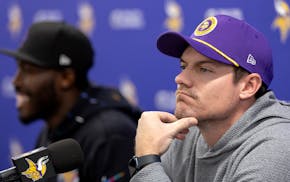A thought came to mind Thursday during a walk toward the first tee for the final day of practice rounds for the 41st Ryder Cup at Hazeltine National Golf Club.
Where would the late Robert Trent Jones Sr. point this patron if asked for the No. 1 spot on the course that could be the most pivotal piece of property once the action starts to count on Friday?
This thought came up when someone looking a whole lot like Robert Trent Jones Sr. was spotted. It was Robert Trent Jones Jr.
Now 77, Junior was fresh off the Yale golf team when he visited Chaska while Senior was creating the original dogleg-heavy design back in 1962. Junior's younger brother, Rees, took over the many redesigns that made and kept Hazeltine big, strong and modern since before the 1991 U.S. Open was held here. But as a member of the first family of fixing Hazeltine, Junior, a course designer himself, surveys the course with a look of pride.
For picturesque viewing, he recommends the obvious choice: the signature par 4 seventh hole (No. 16 for the members) along Hazeltine Lake. For degree of difficulty late in matches, he suggests parking a chair near the 17th green (No. 8 for the members).
"You don't know how many matches are going to get to 17," he said. "But the ones that do, some interesting things could unfold."
But 17 is, at a maximum, 176 yards. It's the shortest par-3 on the course. It can't be that hard, can it?
Well …
Per Jones' advice, a reporter grabbed a pretty-in-pink inside-the-ropes bib and parked right behind the 17th green as three foursomes carrying the 12 greatest American golfers passed through. The golf wasn't pretty, folks.
Only three players — Zach Johnson, Jimmy Walker and Dustin Johnson — hit the smallest green on the course. Only Zach Johnson kept the ball below the pin, which was cut in the narrow front neck of a green that slopes back to front and is guarded by water short and right, and bunkers left and long.
Zach made the uphill 5-footer for the only birdie. Out of 12 American Ryder Cup stars. In only a slight breeze. And with no pressure.
"It's a beautiful par-3," Jones said. "And very difficult to hit."
It's one of the few holes that plays into a typical crosswind. Don't allow for the wind, and the ball ends up in the left bunker. Allow too much for the wind, and you're hitting 3 from the drop zone after going kerplunk.
Rich Beem called the hole "unbelievably tough" while winning the 2002 PGA Championship. Padraig Harrington probably called it a lot worse privately when he took an 8 on the hole while falling out of contention on the final day as the defending PGA Championship winner in 2009.
Thursday, Phil Mickelson hit his first tee ball into the water. He re-teed and missed the green left. Mickelson also was the only American player to practice shots out of the back bunker, taking full driver-speed swings with a sand wedge to pop the ball 3 feet to the back pin positions. Amazing.
Matt Kuchar and Jordan Spieth hit their tee shots into the left bunker. Spieth didn't take his second shot from the bunker. Kuchar probably wishes he hadn't.
With a mighty swing, Kuchar shanked a shot that scattered playing partners and officials before heading into the pond. The crowd roared with laughter, and one fella screamed, "Hey, I could do that!"
But, as Jones mentioned, it's "harder than it looks."
"This course was criticized so much during the 1970 U.S. Open," he said. "But the family didn't give up on it. Neither did the members. This place means a great deal to us because Hazeltine is now a national golf treasure. Don't you think?"
Mark Craig has covered numerous major golf events for the Star Tribune. Twitter: @MarkCraigNFL • E-mail: mcraig@startribune.com
Minnesota's Naz Reid wins NBA's Sixth Man of the Year award, edging Malik Monk in close vote
